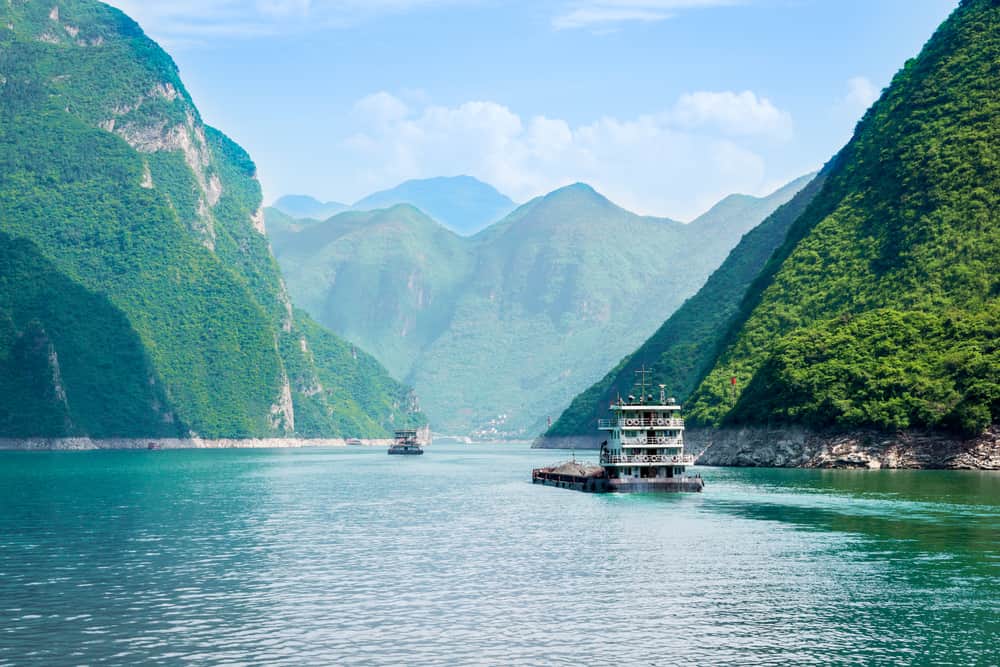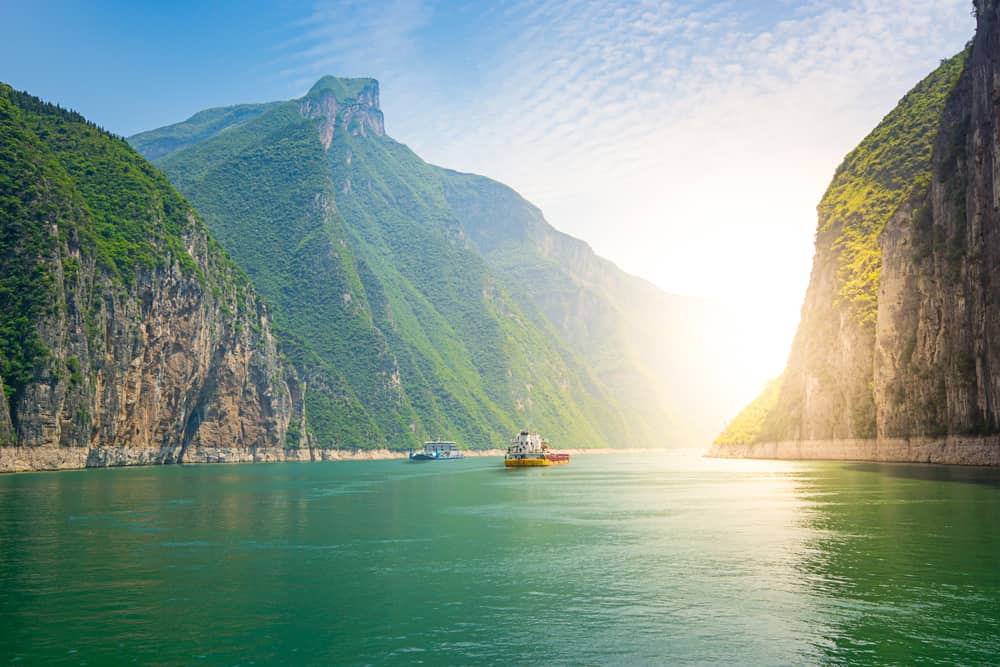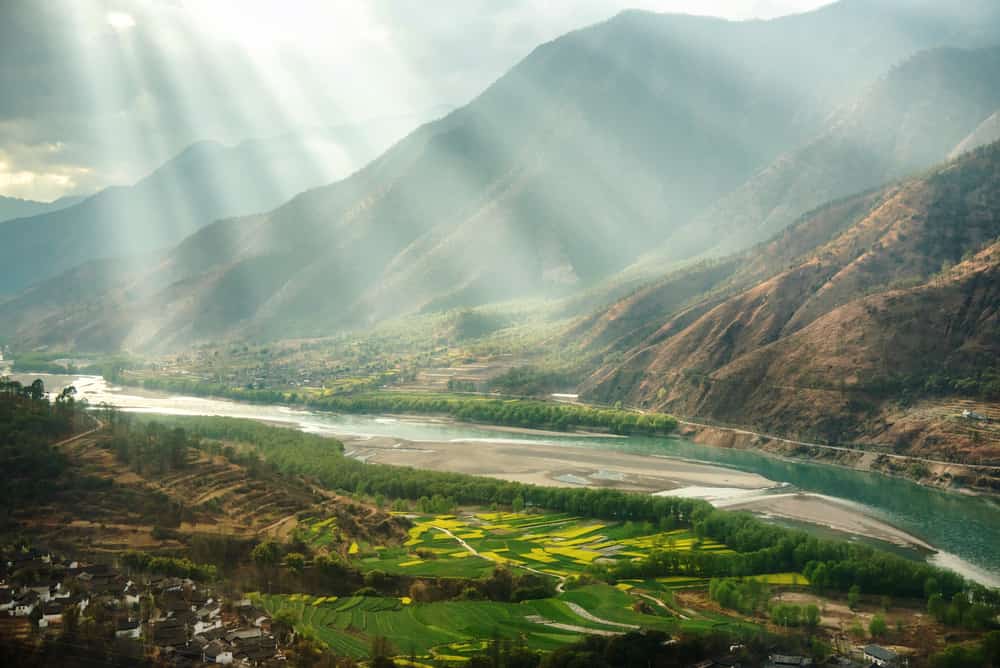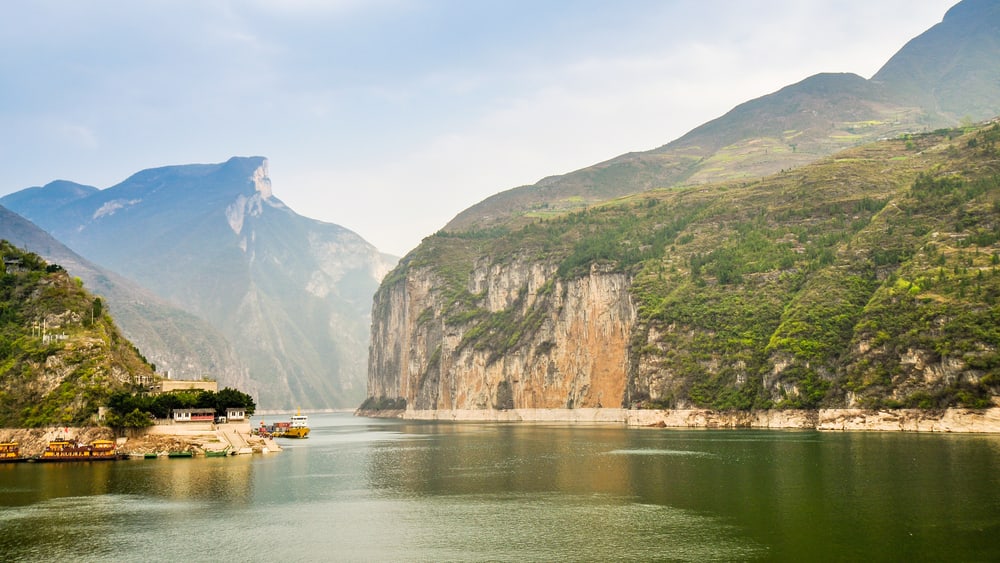
As Asia’s longest river, the Yangtze winds majestically through the heartland of China.
©Daniel Doerfler/Shutterstock.com
Our planet is a treasure trove of natural marvels, with rivers painting some of the most breathtaking strokes on this vast canvas. These flowing wonders do more than just quench our thirst; they weave stories, mold landscapes, and become the lifeblood of entire civilizations.
Within this grand tapestry, the Yangtze River shines brilliantly. It’s not merely about its impressive stretch, but the deep-rooted connection it shares with the heart of China.
Are you ready to dive deep and explore the captivating tale of the Yangtze River? Let’s set sail on this enlightening voyage together!
The Yangtze River and the Titans: A Global Perspective
When we talk about the world’s most magnificent rivers, it’s not just a numbers game. To a great extent, the length and volume matter. However, it’s the stories they tell, the civilizations they’ve cradled in their arms, and the life they breathe into ecosystems that truly count. The Yangtze, with its sprawling expanse and deep-rooted influence on China, is undeniably a titan among these watery wonders. But how does our beloved Yangtze’s size stack up against the other iconic rivers that have shaped our world?
1. The Nile: Africa’s Beating Heart
Ah, the Nile! Often wearing the crown as the world’s longest river, it stretches a jaw-dropping 4,100 miles. Born in the scenic highlands of Burundi and Rwanda, it dances its way north. From there, it waltzes through lakes, swamps, and cataracts, before spreading its arms wide in its renowned delta and whispering its secrets to the Mediterranean Sea.
The Yangtze has its tales, and so does the Nile. Think of the grandeur of Ancient Egypt – the majestic pyramids, the enigmatic pharaohs, and the cryptic hieroglyphs. All these owe their tales to the nurturing banks of the Nile. While the Yangtze is China’s pulsing vein, the Nile is Africa’s age-old guardian, especially cherished by nations like Egypt and Sudan.
2. The Amazon: South America’s Lush Lifeline
Enter the Amazon, the Nile’s friendly rival for the title of the world’s longest river, clocking in at around 4,000 miles. But here’s where the Amazon flexes its muscles – in sheer volume, it’s unparalleled! This river is nature’s powerhouse, releasing more water than the next seven big rivers put together. Born in the towering Andes Mountains of Peru, it journeys eastward. Finally, it takes a rest in the embrace of the Atlantic Ocean. While the Yangtze fuels China’s bustling economy, the Amazon breathes life into our planet. Nestled within the world’s vastest rainforest, the Amazon Basin is like nature’s treasure chest, brimming with biodiversity and secrets waiting to be unveiled.
3. The Yangtze: Asia’s Shimmering Gem
The Yangtze, stretching a commendable 3,915 miles, proudly waves the flag as Asia’s longest river and clinches the bronze medal on the global stage. But the Yangtze’s story is so much more than its impressive length. It’s China’s soul, flowing with pride and purpose within its borders.
From the frost-kissed peaks of the Tanggula Mountains to the vibrant hustle and bustle at the East China Sea, the Yangtze paints a vivid picture of diverse landscapes, thriving ecosystems, and a rich tapestry of cultures. It’s a river that showcases the beauty of contrasts – from time-worn temples that have seen empires rise and fall, to the futuristic silhouette of Shanghai’s skyline.
4. The Mississippi: North America’s Mighty Mainstream
The Mississippi River, often referred to as the ‘Old Man River’, is the chief river of the second-largest drainage system on the North American continent. Stretching about 2,340 miles, it flows from northern Minnesota and meanders southwards, emptying into the Gulf of Mexico.
Much like the Yangtze’s influence on China, the Mississippi has played a pivotal role in the expansion and development of the United States. It also serves as a vital transportation artery and a boundary for state lines.
5. The Danube: Europe’s Binding Thread
Europe’s second-longest river, the Danube, spans about 1,770 miles, flowing through or touching the borders of ten countries. Originating in Germany’s Black Forest, it courses southeast, eventually emptying into the Black Sea. The Danube has been a historical and cultural bridge between Central and Eastern Europe, much like how the Yangtze has connected various regions of China.
6. The Ganges: India’s Sacred Stream
The Ganges, or Ganga, is not just a river in India; it’s a divine entity, a goddess, and the lifeline for millions. Stretching around 1,557 miles, it originates from the Himalayas and flows through the plains, culminating its journey at the Bay of Bengal. While the Yangtze holds economic significance for China, the Ganges is deeply intertwined with the spiritual and cultural fabric of India.
7. The Mekong: Southeast Asia’s Flowing Tapestry
The Mekong River, approximately 2,700 miles long, is Southeast Asia’s longest river. Rising in the Tibetan Plateau and flowing through six countries before emptying into the South China Sea, the Mekong is vital for food, transportation, and culture. This is especially true in countries like Cambodia and Vietnam. Its delta, much like the Yangtze, is a rich agricultural region, feeding millions.
8. The Tigris and Euphrates: Mesopotamia’s Twin Lifelines
These two rivers, flowing mainly through Iraq and converging to form the Shatt al-Arab, have been central to the Fertile Crescent, often dubbed the ‘Cradle of Civilization’. Spanning approximately 1,180 miles (Tigris) and 1,730 miles (Euphrates), they’ve nurtured ancient civilizations like the Sumerians and Babylonians, much like the Yangtze’s role in ancient Chinese dynasties.
These rivers aren’t just water bodies; they’re living, breathing entities. Their stories, etched over millennia, go beyond mere statistics. They’re the lifeblood of the regions they flow through, echoing their history, mirroring their culture, and symbolizing their dreams.
The Yangtze River, in the heart of Asia, is a testament to China’s resilient spirit, its storied past, and its vision for the future. In the intricate weave of the world’s most iconic rivers, the Yangtze shines brightly, threading its narrative with elegance, might, and timeless charm.

Ships journeying down the Yangtze highlight its role as China’s primary transportation artery.
©Daniel Doerfler/Shutterstock.com
The Yangtze’s Economic Pulse: The River That Powers a Nation
Picture this: a river that doesn’t merely meander through landscapes but pulsates with the heartbeat of an entire nation’s economy. That’s the Yangtze for you. It’s not just a waterway; it’s China’s economic artery, pumping life and prosperity through the vast expanse of the country.
1. Irrigation: Nourishing Fields and Dreams
The Yangtze is famous as a generous nurturer. The sprawling plains cradling its banks are a testament to its benevolence. Thanks to the Yangtze’s waters, these lands are fertile havens where agriculture doesn’t just survive; it flourishes. Think of vast green paddy fields, golden stretches of wheat, and aromatic tea gardens. These crops, nourished by the river, not only feed millions but also form the backbone of rural economies. Today, the river continues ensuring livelihoods and lighting up homes with hope and prosperity.
2. Hydroelectric Power: The Mighty River’s Mightier Role
The serene flow of the Yangtze hides a fierce power beneath. It’s no exaggeration to call this river an energy titan. Marvels of engineering like the Three Gorges Dam stand tall on the Yangtze, converting its kinetic energy into electricity. This hydroelectric prowess lights up cities, powers industries, and ensures that the wheels of progress never stop turning. The Yangtze, in its majestic flow, ensures that China stays illuminated, both literally and metaphorically.
3. Transportation: The Ancient Highway with Modern Significance
Long before highways and railways crisscrossed China, the Yangtze was the mainstay of transportation. And guess what? Its role hasn’t diminished one bit.
Today, the river is abuzz with cargo ships, big and small, ferrying goods from one part of the country to another. It’s like the bloodstream of China’s trade system, ensuring goods move seamlessly, markets stay vibrant, and the economy thrives. The Yangtze, with its strategic routes, bridges the past’s traditions with the present’s dynamism.
4. Industry: The Economic Powerhouse on the Riverbanks
When you approach the Yangtze River Delta, you’ll witness a spectacle of modernity. The riverbanks, once silent witnesses to the river’s flow, now hum with activity. From sprawling manufacturing units churning out goods for global markets to cutting-edge tech hubs pushing the boundaries of innovation. Thanks to the Yangtze River, the region is a testament to China’s economic ambitions. The Yangtze, with its abundant resources, has made this region a beacon of industrial growth, significantly bolstering China’s GDP.
In short, the Yangtze River, in its flowing melody, orchestrates a symphony of economic progress. Every ripple tells a story of growth, and every current speaks of ambition. Every bend whispers tales of prosperity. More than just a river; it’s the lifeblood of a nation’s dreams and aspirations.
The Yangtze: A Timeless Tapestry of Tales
As you stand by the banks of the Yangtze, close your eyes and listen closely. You’ll hear more than just the gentle lapping of water. You’ll hear echoes of ancient tales, whispers of bygone eras, and the soft hum of a civilization that has thrived alongside this mighty river for millennia. The Yangtze isn’t merely a body of water; it’s a storyteller, narrating China’s rich tapestry of history, culture, and evolution.
Ancient History: Echoes from the Dawn of Time
The Yangtze’s banks are much more than just stretches of land; they’re pages from a living history book. These shores have cradled civilizations that predate even some of the world’s most ancient cultures. Imagine, if you will, communities from the Neolithic age, making tools, crafting pottery, and building the foundations of what would become the mighty Chinese civilization. Every artifact unearthed, from ancient pottery shards to primitive tools, is a testament to the river’s age-old role as a nurturer of life and culture.
Cultural Significance: The River as a Muse
Throughout the ages, the Yangtze has been a fountain of inspiration. Poets, gazing at its shimmering waters under the moonlight, have penned verses that resonate with beauty and depth. Artists, inspired by the river’s ever-changing moods, have captured its essence in strokes of brilliance. Philosophers, by its banks, have pondered life’s deepest mysteries. The Yangtze is a canvas, a parchment, and a stage where China’s cultural soul expresses itself.
Historical Conflicts: The River’s Turbulent Past
The Yangtze’s tale isn’t just one of beauty and inspiration. It has its share of tumult and turbulence. The river has borne silent witness to battles that have changed the course of history. The most iconic of these is the Battle of Red Cliffs, where strategies were devised, alliances were forged, and destinies were altered. As the mists of time rolled in, the Yangtze watched, recording every clash of swords and every war cry, preserving them in its depths.
In summary, the Yangtze River, in its flowing majesty, is a bridge between China’s past and present. It’s a living chronicle, a guardian of tales, and a beacon of the nation’s cultural and historical spirit. As the river continues its journey, it carries with it the weight of ages, the dreams of generations, and the promise of many tomorrows. It’s not just a river; it’s the soul of a civilization.

Thanks to the Yangtze’s nourishing waters, the surrounding plains are lush and ideal for agriculture.
©martinho Smart/Shutterstock.com
The Yangtze River: Nature’s Masterpiece Unveiled
When you think of the Yangtze, it’s not just about the water that flows; it’s about the incredible journey it undertakes, painting a vivid tapestry of landscapes as it winds its way from the lofty Tanggula Mountains to the expansive embrace of the East China Sea. Every stretch of this river tells a story, a blend of nature’s artistry and the indomitable spirit of human civilization.
Upper Yangtze: Where Rugged Meets Majestic
Starting its journey in the high-altitude embrace of the Tanggula Mountains, the Upper Yangtze is a testament to raw, untamed beauty. Here, the river carves its way through deep canyons and imposing gorges, each twist and turn revealing a new spectacle. The iconic Three Gorges, with their towering cliffs and echoing waters, stand as nature’s grand amphitheater, leaving onlookers in awe of their magnificence.
Middle Yangtze: A Mosaic of Nature and History
As the river winds its way downstream, the fierce ruggedness gives way to a serene blend of nature and history. The Middle Yangtze is a realm where emerald forests meet shimmering lakes, and where every bend might reveal an ancient city with tales as old as time. It’s a region where the whispers of the past harmoniously blend with the songs of nature, creating a symphony that resonates with the soul.
Lower Yangtze: Where Nature’s Brilliance Meets Human Endeavor
Approaching its final leg, the Yangtze unfurls into a sprawling delta. This section of the river is a testament to both nature’s grandeur and human innovation. This intricate network of waterways is not just a geographical wonder but also the lifeblood of economic activity. Nestled within this delta is the pulsating heart of Shanghai, a city that stands as a beacon of modernity and progress. The Lower Yangtze is a beautiful dance of nature and human achievement, a place where the river’s timeless journey meets the ever-evolving story of humanity.
The Yangtze’s Delicate Balance: Beauty Under Siege
While the Yangtze’s journey paints a picture of natural splendor and cultural richness, there’s another side to its story – one of pressing challenges and looming threats. As China surges forward in its quest for modernization and growth, the Yangtze finds itself at a pivotal juncture, grappling with the consequences of human progress and environmental shifts.
Pollution: The Dark Shadow Over Crystal Waters
Once a symbol of purity and life, parts of the Yangtze now bear the brunt of unchecked industrialization. Factories, in their quest for production, often overlook environmental safeguards, releasing untreated waste into the river. This not only disrupts the delicate aquatic ecosystem but also poses severe health risks to countless communities that consider the Yangtze their lifeline. The once-clear waters now sometimes carry with them the weight of pollutants, a stark reminder of the price of progress.
Habitat Destruction: The Silent Crisis
The sprawling urban landscapes, while a testament to human achievement, come at a cost. As cities expand and infrastructure projects take root, the natural habitats along the Yangtze are under threat. Wetlands, forests, and other crucial ecosystems are being replaced by concrete and steel. This not only endangers a myriad of species that call the river home. It also disrupts the natural balance, leading to unforeseen consequences for the environment and people alike.
Climate Change: The Unpredictable Foe
The global specter of climate change doesn’t spare the Yangtze. With temperatures on the rise and rainfall patterns becoming increasingly erratic, the river’s very essence is at risk. These changes can lead to altered flow patterns, affecting everything from agriculture to the river’s rich biodiversity. The Yangtze, like many natural wonders around the world, is on the frontline of the battle against climate change. As a result, its future is uncertain in a warming world.
The challenges facing the Yangtze are a microcosm of the broader environmental issues confronting our planet. As the river navigates these troubled waters, it serves as a poignant reminder of the delicate balance between progress and preservation. The Yangtze’s tale is not just a call to appreciate its beauty but also an plea to protect and cherish it for generations to come.

Efforts are being made to rejuvenate and protect the delicate ecosystem of the Yangtze, highlighting the importance of conservation in action.
©jejim/Shutterstock.com
The Yangtze River Revival: Turning the Tide with Conservation
While the Yangtze’s narrative has its share of challenges, it’s not all gloom and doom. Amidst the concerns, there’s a burgeoning movement of hope and resilience. From government corridors to local communities and global platforms, there’s a collective realization of the river’s importance. As a result, there’s now a determined push to ensure its protection and rejuvenation.
Legislation: Charting a Sustainable Course
The introduction of the “Yangtze River Protection Law” is a testament to the government’s commitment to the river’s well-being. This legislation isn’t just a set of rules; it’s a vision. It seeks to harmonize the often conflicting goals of economic growth and environmental preservation. By setting clear guidelines and regulations, it aims to ensure that the river’s health isn’t compromised in the race for development.
Community Initiatives: The Power of Grassroots Movements
Change often starts at the grassroots, and the Yangtze’s story is no different. Local communities, who’ve lived by the river for generations, are now its fiercest protectors. Through awareness campaigns, clean-up drives, and sustainable practices, they’re not just highlighting the river’s challenges but actively participating in its revival. Their intimate connection with the Yangtze ensures that these efforts are not just superficial but deeply rooted in understanding and respect for the river.
International Collaboration: A Global Endeavor
The Yangtze’s tale transcends borders. Recognizing its global significance, international organizations, research institutions, and conservation bodies are joining hands with Chinese counterparts. These collaborations focus on sharing knowledge, best practices, and resources. Whether it’s cutting-edge research to understand the river’s ecosystem better or devising sustainable development models, the global community is rallying behind the Yangtze’s cause.
The road to conservation is long and filled with challenges, but with concerted efforts and a shared vision, the Yangtze’s future looks promising. It’s a testament to the human spirit’s ability to recognize, rectify, and rejuvenate. As we move forward, the Yangtze serves as a beacon, reminding us of the delicate balance between nature and progress and the collective responsibility we hold in preserving our planet’s treasures.
Journey’s End: The Yangtze River’s Timeless Tale
As we’ve journeyed along the Yangtze, from its humble origins in the Tanggula Mountains to its grand confluence with the East China Sea, we’ve not only traced its impressive length but also delved deep into its soul. The Yangtze stands as a testament to nature’s grandeur and the intricate tapestry of life it supports.
But the Yangtze’s story isn’t just about its stature among the world’s longest rivers. It’s about the civilizations it has cradled, the economies it has fueled, and the challenges it bravely faces. In comparing it to the likes of the Nile and the Amazon, we recognize that the true essence of these rivers isn’t just in their lengths but in the stories they tell, the lives they touch, and the histories they’ve shaped.
In the end, the Yangtze, like its global counterparts, serves as a poignant reminder of our planet’s incredible natural wonders and the delicate balance we must maintain to ensure their survival. As we reflect on the Yangtze’s vast expanse and profound significance, let’s also remember our role in preserving its legacy for generations to come. After all, the true measure of a river isn’t just in its length but in the depth of its impact on the world.
The photo featured at the top of this post is © iStock.com/martinhosmart
Thank you for reading! Have some feedback for us? Contact the AZ Animals editorial team.






